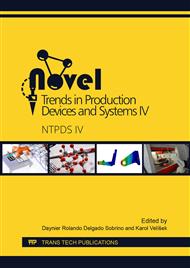p.292
p.299
p.307
p.315
p.327
p.335
p.345
p.354
p.362
The Size of the Friction Coefficient of the Sliding Pair Depending on the Lubricant Used
Abstract:
Tribometry Methods are Focused on the Research of Tribological Processes. these Method Also Include Model Tests on Experimental Equipment, which Operate in Exactly-Defined Mode. Input Parameters of Tests are Transparent and Easy to Maintain Constant. Outputs Variables, which are Recorded, Represent Characteristic Parameters of Tribological Processes. Tests are Carried out on Simple Test Samples. the Aim of these Methods is to Numerically Express the Magnitude of Friction Force, Friction Moment, Respectively Determinate the Friction Coefficient. the Contribution is Focused on Determining the Friction Coefficient for Brass and Steel Test Samples. the Measurements were Realized on a Test Machine Tribotestor M`89. Size of the Sliding Velocity and Size of the Loading Force were Entered to the Tests as Input Parameters. Two Types of Oil were Used in the Experiments: Castrol Manual EP 80W and Madit PP90. the Results Obtained Show that the Friction Coefficient Value Decreases with the Increasing Normal Load for both Materials and Also for both Lubricants. Smaller Friction Coefficient Values were Achieved Using Lubricant Castrol Manual EP 80W for both Materials. the Average Values of the Friction Coefficient under the Load Conditions Ranged from 0.056 to 0.1240.
Info:
Periodical:
Pages:
327-334
Citation:
Online since:
April 2018
Authors:
Keywords:
Price:
Сopyright:
© 2018 Trans Tech Publications Ltd. All Rights Reserved
Share:
Citation:


